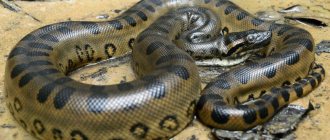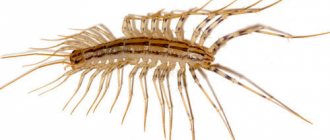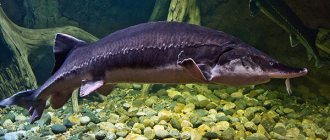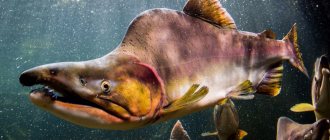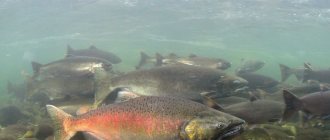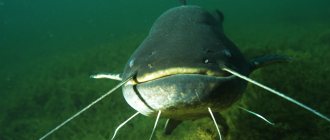The seabed contains many stones - all shapes and colors. But by stepping on a stone, you can get a portion of poison, because this very stone may turn out to be a living creature, whose name is the stone fish.
A photo of a stone fish can tell a lot about this underwater inhabitant. Take a closer look, this representative of the scorpionfish family, at first glance, does not look very much like a fish. Its appearance is more reminiscent of an underwater cobblestone overgrown with algae and mud.
Stonefish (Synanceia verrucosa).
This fish is also considered one of the most poisonous in the world. Another name for stone fish is wartfish. The fish received this name for its unsightly and even ugly appearance.
Appearance and description
The average length of most adult warts ranges from 35-50 cm . The main coloring of the stonefish's body varies from mottled greenish shades to a relatively rich brown color, which allows the deadly sea creature to easily hide among numerous tropical reefs.
The specific features of such a fish are a fairly large head, small eyes and a small mouth directed upward. There are numerous ridges and tubercles on the head. The pectoral fins have a very wide and distinctly oblique base. All twelve thick spines on the dorsal fin of the stone fish, like any other species of fish from the genus Wart, have poisonous glands.
This is interesting! Unusual are the eyes of the stone fish, which, if necessary, are capable of not only completely hiding in the head, as if drawn into it, but also going out as much as possible.
Return to content
Characteristic
The stone fish is a predator that paralyzes its prey with its poison, and while it is lost from such sudden paralysis and pain, it attacks and eats it. Externally, the wart looks unremarkable, as photos of the wart demonstrate. These are mostly small individuals about 40-30 cm long. Their entire body is covered with special warts, scales and irregularities that look like stones or reefs. For such skin, the animal received a second name - fish - wart.
The color of the fish is usually dark brown, dark green or sandy in color, as shown in the photo. The color tone looks different depending on the environment, since the animal knows how to mimic it.
Main appearance characteristics:
- large head with small eyes and a huge mouth;
- the front fins are located lower on the chest, standing obliquely in relation to the body;
- the dorsal fin consists of 12-14 spines, which the warthog can retract and release. These spines contain glands that produce a deadly cocktail;
- she has three more pelvic and two anal tweezers with a toxic secretion;
- the whole body is covered with warts, growths and other irregularities.
Yandex pictures
The fish lives mainly on the bottom of oceans and seas, and also loves to settle in coral reefs. Here she can calmly track and burn her prey, and a large number of delicious victims will always swim by.
The animal loves shallow water with a lot of stones, algae or reefs - different places where you can hide. She leads a sedentary lifestyle.
When the warty fish senses the slightest movement of the water and the approach of prey, it releases sharp spines from its back. They contain deadly poison. When exposed to the toxin, the victim is instantly struck by acute pain and paralysis gradually develops. At this moment, the predator attacks its prey.
The warthog's main diet is small fish, shrimp, and other crustaceans. The wart swallows its prey whole and digests it, which is how it copes with the shell of shrimp or crustaceans.
Interesting! The wart can wait motionless for prey for days, but when the right moment comes, it instantly attacks. This is not only the most poisonous, but also the fastest fish in the world. From the moment of the injection to the attack, only 0.015 seconds can pass. During this time, it will have time to turn around, grab and swallow the victim whole.
Due to its unusual appearance and reputation as the most dangerous fish, it can often be found in the aquariums of restaurants and shopping centers. Since many warts were found near the coast of Japan, in the traditional cuisine of this country these animals are often used to prepare various dishes:
- sashimi;
- sushi;
- soups
Despite the presence of a secret in the thorns, the meat of stone fish is extremely tasty and healthy. It is different:
- delicate texture;
- high protein content;
- high content of Omega-3 polyunsaturated fatty acids.
It is for these qualities that this meat is so valued in Japan, where it is a very expensive delicacy. However, before cooking, the entire back part with spines is completely removed from the carcass.
Range and distribution
The wart is especially widespread in the southern tropical zone, as well as in shallow waters in the Pacific and Indian Oceans.
Large numbers of stonefish are found in waters from the Red Sea to the Great Barrier Reef area near Queensland. The main distribution area also includes the waters of Indonesia, the water area around the Philippines, and the waters surrounding the islands of Fiji and Samoa.
This is interesting! It should be noted that the wart is the most common species of the Scorpionidae family, so you can encounter such poisonous fish on the popular beaches of Sharm el-Sheikh, Hugarda and Dahab.
Return to content
Scorpena
The Black Sea scorpionfish is a predatory fish of the scorpionfish family, to which it gave its name. It lives in the Black and Mediterranean Seas, the eastern part of the Atlantic Ocean, and is sometimes found in the Sea of Azov. Spends most of its time in the thickets on a rocky bottom, waiting for prey.
Scorpena: Wikipedia
The scorpionfish has very tasty meat, but it is dangerous for scuba divers, fishermen and cooks because its bone spines and spines contain poison. The poisonous fish mucus that gets into the wound causes severe inflammation.
Lifestyle of stone fish
The wart's main habitat is coral reefs, rocks darkened by algae, bottom mud or sand. The warty fish is a sedentary fish, which, due to its external characteristics, prefers to stay in shallow water, near the coastline, next to coral reefs or lava piles.
The stone fish spends almost all its time lying down, burrowing into the bottom soil or masquerading as reef stones, abundantly overgrown with mud . This position of the sea creature is not only its way of life, but also its way of effective hunting. As soon as a wart notices an object suitable for feeding, it almost instantly attacks it. During the year, the stone fish is able to change its skin several times.
In a fish immersed in the ground, only the surface of the head and the area of the back are visible, to which water debris and grains of sand stick en masse, so it is almost completely impossible to notice such a marine inhabitant not only in the water, but also on land, where the fish often finds itself during high tides.
Return to content
Greater sea dragon / Trachinus draco
This predatory fish is also called the sea scorpion, since its spines contain poisonous glands. These spines are located on the gills and fins of the dragon.
They live in the Atlantic, as well as in the waters of the Mediterranean and Black Seas. They grow up to 45 cm and are classified as perciformes. While waiting for prey, it buries itself in the silt or sand at the bottom, and only its eyes remain on the surface. But the dragon itself becomes prey. The meat is edible and is an exquisite delicacy in restaurants in European countries.
For humans, the touch of a poisonous thorn is quite painful. The fish itself is considered one of the most poisonous sea creatures in Europe. In history, deaths have been recorded after the meeting of a man and a large sea dragon.
By the way, on our website most-beauty.ru there is an interesting article about cannibal fish.
7
Reproduction
In recent years, warts have often been kept in home aquariums, but successful attempts at breeding in captivity are unknown to date.
In their natural habitat, the stone fish leads a very secretive lifestyle and is well camouflaged, so very little is known about the process of reproduction of the offspring of such aquatic inhabitants, and such information cannot be considered completely reliable.
Return to content
stingray
The stingray is a representative of the family of cartilaginous fish of the order Stingrays of the superorder of stingrays. These stingrays live in all tropical and subtropical seas. They lead a bottom-dwelling lifestyle and are found in coastal areas, mangroves and brackish estuaries. They have a flat body and a long poisonous tail.
Stingray: Wikipedia
According to legend, Odysseus died from a spear with a stingray. It was because of an attack by a stingray and a stab in the heart that the famous naturalist Steve Irwin died.
Danger of stone fish poison
The warty fish is able to survive even in a waterless environment for almost a day, therefore, well camouflaged as surrounding landscape objects, the stone fish often becomes the cause of human injury. It's all about the presence on the dorsal part of a number of spikes that emit very toxic substances. When poison gets under the skin, a person experiences severe pain, which is often accompanied by symptoms such as shock, paralysis, cardiac arrest, respiratory failure and tissue death.
Even minor irritation provokes the wart to raise the spines of the dorsal fin . Very sharp and quite strong spikes can easily pierce even the shoes of a person who accidentally steps on such a fish. Deep penetration of thorns and untimely assistance can cause death.
Important! It is especially dangerous if the poison gets directly into the blood. The toxin is represented by a protein mixture, including hemolytic stonustoxin, neurotoxin and cardioactive cardioleptin.
First aid for such an injury consists of applying a strong constricting bandage or hemostatic tourniquet just above the wound. To relieve pain and burning, apply hot compresses and treat the wound with pharmaceutical anesthetics.
However, qualified medical care must be provided to the victim as quickly as possible, since local damage to the nerve can cause severe atrophy of muscle tissue.
Return to content
Consequences of the injection
Immediately after contact with this predator, a person may not even realize that he has become a victim. The presence of injury can be determined by increasing pain, which occurs after some time and leads to damage to the nerve center. The victim may lose consciousness from shock, sometimes paralysis occurs, tissue atrophy and there is a possibility of choking. The wounded person must be urgently taken to the local medical center so that he can receive prompt assistance:
- The first medical measure is an injection of a conventional anesthetic.
- Next, the wound is washed with a disinfectant solution of potassium permanganate.
- If the spines are stuck in the body, they will need to be removed, sometimes through surgery.
- You can relieve atrophy with a hot compress.
- The harmful effects of the protein poison “verrucotoxin” are removed with the help of the necessary antidote.
After successful implementation of these measures, the “odyssey” of the unfortunate person will continue for several more months. Even after mobile rescue efforts, the patient will still remain in a hospital bed, such are the consequences of a dangerous toxin. Despite numerous warnings from tourists, people, including aborigines, still die from the injections of this insidious fish.
Remember: If a barb needle pierces one of the large blood vessels of a person, he can die within a couple of hours.
Katran / Squalus acanthias
Our rating of the most poisonous fish on most-beauty.ru continues with the Black Sea shark Katran. It is not dangerous for humans, like its oceanic relatives, but the spines contain a small amount of weak poison.
It reaches a length of up to 2.20 meters, and the maximum weight is 30-35 kg. In addition to the Black Sea, it is found in limited areas of the Atlantic. Poison is a heterogeneous protein. When the injection occurs, redness and a severe burn begin, which goes away after a few days.
This is the most common species of shark in the world, but the only one that is found in the Black Sea. Katrans prefer to stay near the bottom, but stay freely in the middle water column. This habit of swimming near the bottom makes them difficult to study.
3
Sea eels / Anguilliformes
Sea eels have a serpentine body shape, and some species grow up to 3 meters in length. The warm tropical waters of the seas and oceans were chosen as their habitat. The largest is the giant moray eel, which is also the most aggressive.
Eels eat shellfish, which contain poison in their bodies. Other fish may die in this case, but eels have adapted to the poison and it accumulates over time in the organs and meat of the fish. Thus, eels become deadly if eaten.
At the same time, the person begins to have difficulty breathing. There is a metallic taste in the mouth, and complete or partial paralysis occurs. Doctors reported death in 10% of people poisoned by eel meat.
?
Brown rocktooth / Takifugu rubripes
The photo shows a poisonous sea fish from the pufferfish family, from which an exotic dish is traditionally prepared in Japan. Gourmets all over the world dream of trying it. The Brown Clifftooth is found near the Japanese islands.
In Japanese cuisine it is known as Fugu Fish. In total, about 26 species of rocktooth are known that are suitable for preparing such a culinary masterpiece. Adults reach 80 cm in length. There are large dark spots along the body. In moments of danger, it swells, thereby scaring away natural enemies. Because of her slowness, she cannot hide, and therefore simply puffs up.
It takes many years to learn how to cook this fish, as most of its organs are deadly poisonous. Improper preparation will result in instant death.
2


